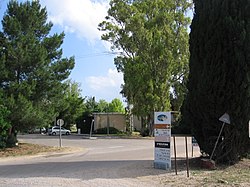Shomrat
Shomrat
שָׁמְרַת | |
|---|---|
 | |
| Coordinates: 32°57′4″N 35°5′44″E / 32.95111°N 35.09556°E | |
| Country | Israel |
| District | Northern |
| Council | Mateh Asher |
| Affiliation | Kibbutz Movement |
| Founded | 29 May 1948 |
| Founded by | Czechoslovak, Hungarian and Romanian Hashomer Hatzair Members |
| Population (2022) | 688[1] |
| Website | www.at-shomrat.com |
Shomrat (Hebrew: שָׁמְרַת) is a kibbutz in northern Israel. Located in the western Galilee on the coastal highway just north of Acre, it falls under the jurisdiction of Mateh Asher Regional Council. In 2022 it had a population of 688.[1]
History[edit]
The kibbutz was established on 29 May 1948 by Hashomer Hatzair members from Czechoslovakia, Hungary and Romania on land that had belonged to the depopulated Palestinian village of al-Manshiyya, north of the village site,[2] and also incorporated some land from al-Sumayriyya.[3][4] Some of the founders had fought with the partisan forces against the Nazis in Europe, while the majority came out of various Nazi concentration camps. Most of the kibbutz founders made their way to Palestine as part of the Aliyah Bet organization, and were consequently interned in DP camps in Cyprus. The founders originally resided in the agricultural experimental government station near Acre, and moved to the permanent location in 1950.[5]
Designer Tzuri Gueta attended secondary school at Shomrat, and his first job was in the kibbutz knitting factory.[6]
On August 22, 1988 a chocking event occurred for inhabitants, they were informed of a gang rape.[7]
Economy[edit]
In 1993, the kibbutz opened a cotton spinning and knitting factory.[6]
Following the collapse of Shomrat's industrial enterprises at the end of the 1990s, Shomrat reorganized itself on the renewed kibbutz model, instituting a differential pay scale and deep privatization of kibbutz services.[8]
References[edit]
- ^ a b "Regional Statistics". Israel Central Bureau of Statistics. Retrieved 21 March 2024.
- ^ Khalidi, Walid (1992). All That Remains: The Palestinian Villages Occupied and Depopulated by Israel in 1948. Washington D.C.: Institute for Palestine Studies. p. 23. ISBN 0-88728-224-5.
- ^ Morris, Benny (2004). The Birth of the Palestinian Refugee Problem Revisited. Cambridge University Press. p. xx. ISBN 978-0-521-00967-6.
- ^ Khalidi, p. 30
- ^ Mapa's concise gazetteer of Israel (in Hebrew). Yuval El'azari (ed.). Tel-Aviv: Mapa Publishing. 2005. p. 530. ISBN 965-7184-34-7.
{{cite book}}: CS1 maint: others (link) - ^ a b Tzuri Gueta, once a struggling designer is now the toast of Paris Haaretz
- ^ "This Week in Haaretz 1988 11 Men Accused of Raping Kibbutz Shomrat Girl". Haaretz. Retrieved 2023-07-11.
- ^ Kershner, Isabel (2007-08-27). "The Kibbutz Sheds Socialism and Gains Popularity". New York Times. Retrieved 2010-01-12.

